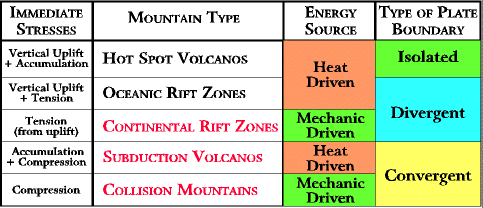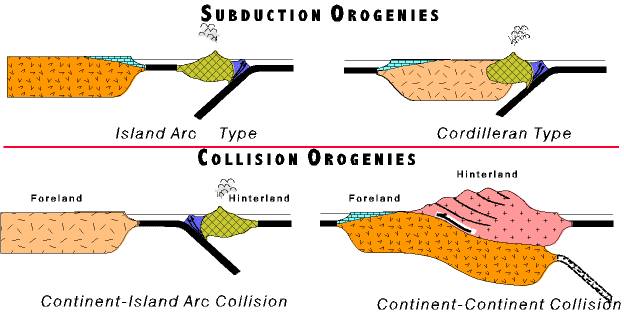 Mountain Building Models And the Geologic History of Virginia Introduction to Mountain Building Models In the past 1.1 billion years the eastern seaboard of North America has experienced four major mountain building events, the Grenville, Taconic, Acadian, and Alleghenian. Virginia has a good record of each of these. But do these mountain building events include the modern Appalachian mountains? In a word, No. For many people a mountain is just some place that has an elevation significantly higher than the surrounding area. The Appalachian "mountains", for example, or the Blue Ridge "mountain." You know they are mountains if you have ever tried to climb them; it takes a lot of time and effort, and the view at the end is worth it. But when we speak of mountains here we speak of them geologically, and that is often not the same thing as the everyday term "mountain." The modern Appalachian mountains, for example, are not "mountains" in a plate tectonic sense. That is, they have not been created by dynamic forces currently thrusting the land upward. The Appalachian mountains are in fact more complex than that. The rocks that make up the mountains are the fragmented, eroded remains of at least four ancient mountains that were huge compared to the present ones (anywhere from 5 to 10 times taller). And the structures in the rocks that give the Appalachian mountains their distinctive valley and ridge shapes and sizes are ancient structures created in a former mountain 300 million years old, and long since dead and gone. Instead the modern Appalachian mountains are the result of a gentle, almost passive uplift, followed by erosion that has removed the soft rock in the valleys, and left the hard, resistant rocks at the ridges. It is the last few subdued breaths before the whole region goes to sleep. So, when we talk about "mountains" in the geologic history we are talking about something different, something more dynamic and powerful than the modern Appalachian mountains. "Real" mountains. But there are so many kinds of mountains in the world today, mountains that are dynamic and powerful. We need some system, some models, for understanding the different kinds of mountains so that we can distinguish them in the history. Mountain Building Models What we are interested in are mountains that result from plate tectonic processes. It is not easy to provide a clean classification here since the processes over lap. But we can look at mountain building from two perspectives, the energy source driving it (heat vs mechanical), and the relationship to plate tectonics (divergent, convergent, and transform boundaries, and within plates). The table below illustrates some of the processes and how they overlap, although we do not attempt to be complete about this.  It is important to recognize that all mountain building ultimately comes from heat, but we are not interested in the ultimate cause, but the immediate cause of the mountain. And, very commonly, more than one of these mechanisms may operate at the same place, either at the same time, or sequentially. Energy Source Mountain Building: Heat vs Mechanical Energy First, is mountain building resulting primarily from heat. The uplift comes because heat from inside the earth heats the overlying lithosphere, causing it to expand, lifting and swelling the surface upward. Often associated with this are volcanos that accumulate even higher on top of the swollen earth. These processes include hot spot and subduction volcanos. Hot spot volcanos are discussed in the rifting model. Subduction volcanos are generated along subduction zones at convergent plate boundaries; they are cordilleran mountains, discussed below. Second, is mechanical mountain building; that is, tension (pulling apart) and compression (squeezing together). The relief (differences in elevation) come primarily because different blocks of earth move relative to each other, either falling or rising vertically, or one block being shoved (thrust) horizontally over another. Plate Boundary Mountain Building Mountain building is associated with all three kinds of plate boundaries, divergent, convergent, and transform. We only deal with divergent and convergent plate boundaries. On a dynamic earth things change fast, or easily transform from one thing into another. For example, the Wilson cycle explains that events begin with divergent plate boundaries (tension producing rifting), but end in convergent plate boundaries (compression leading to collision). It is this dynamic we want to capture in the classification below. Below we discuss only the mountain types written in red in the table above, although clicking on any mountain type will take you to a fuller discussion of it somewhere.  PLATE BOUNDARY MOUNTAIN CLASSIFICATIONS Divergent Plate Boundaries: Continental Rift Zones New divergent plate boundaries are created at continental rifting centers by tension (pulling apart). In the rifting model this mechanism is explored in more detail. Here we just look at the principles of tensional mountain building.  Tensional mountain building is almost always of the block faulted type (horsts and graben). Any condition that pulls the earth apart can cause this faulting. For this to occur something must create the tension, must pull the earth apart. There are circumstances where the tensional stresses operate horizontally, parallel to the earth's surface (for example at transform plate boundaries), but many times the tension occurs because the earth is lifted upward from below by heat, such as at a hot spot. Lifting the earth upward is something like blowing up a balloon; the surface stretches. Tensional mountain building is almost always of the block faulted type (horsts and graben). Any condition that pulls the earth apart can cause this faulting. For this to occur something must create the tension, must pull the earth apart. There are circumstances where the tensional stresses operate horizontally, parallel to the earth's surface (for example at transform plate boundaries), but many times the tension occurs because the earth is lifted upward from below by heat, such as at a hot spot. Lifting the earth upward is something like blowing up a balloon; the surface stretches.When the earth stretches the brittle rocks crack into blocks, and a gap opens as the earth spreads apart. Into the gap a block of the earth slides down because of gravity. The graben is the down faulted block, and as it goes down a valley is formed (drawing to right). The blocks on either side of the valley that do not slide down are the horst mountains. This process occurs in tens of thousands of tiny steps, each creating a small gap, the sum total of which stretches the earth apart many kilometers. It is possible, of course, for the horst block to move up, but most of the time it does not matter; only relative motion is observed. Relatively if one block goes up the other must have gone down, and vice versa. Convergent Plate Boundaries: Subduction Zones Convergent plate boundaries exist when two plates move toward each other. Convergence begins when oceanic lithosphere decouples, that is, breaks at some place and descends into the mantle along a subduction zone. It is always oceanic crust that decouples and descends. Continental crust is too light to subduct. Subduction zones can form anywhere in an ocean basin, and face any direction. Also, more than one subduction may be active in an ocean basin at the same time. Thus a complex sequence of mountain buildings are possible, and are not unusual. Convergent mountain building is also complex in its mechanisms, since although convergence is compressive, mountains may be either heat driven, or mechanically driven, or a combination of them. But even in the heat driven examples, it is compression that is ultimately generating the heat so we have to understand the relationships and processes operating. A simple classification is possible, however, and is shown in the illustration below. Mountains result from either subduction or collision.  Subduction Orogeny Two kinds of subduction orogenies exist, those within ocean basins (island arc type), and those that descend under continents (cordilleran type). The island arc type orogeny is illustrated by the islands of Japan, and the Aleutian islands. Here uplift is mostly heat driven as magma rises off of the subduction zone. In addition, the volcano itself builds a mountain on top of the swelling. The cordilleran type mountain building is illustrated by the Andes mountains, or the Cascades. Here also, heat swells the continent upward, and then volcanos build even higher on top of that. Both of these subduction orogenic types have numerous processes, and generate a wide diversity of rocks and structures. For full details and explanations see the Wilson Cycle, Stages E and G. Collision Orogeny The second class of convergent plate orogenies are collision orogenies. We recognize two types, continent-island arc type, and continent-continent type. In both cases an ocean basin descends completely down a subduction zone until it disappears completely. These are called "remnant ocean basins" (ROB) since they are only a remnant of their former selves. The two floating blocks on either side of the remnant ocean then have no choice but to collide. The floating blocks may be island arcs, or microcontinents, or continents, or some combination of these. In the cross sections above the continent-island arc collision has not taken place yet, but is imminent. The continent-continent collision has occurred and the one continent overridden the other. In both cases the subduction zone acts as a ramp, and one block will slide up over the other. The overriding block is a hinterland; the overridden block the foreland. Observe, that it is not possible to get collision orogenies without at least one of the floating blocks having a subduction orogeny first (island arc or cordilleran type); it is the only way an ocean basin can close. As with the subduction orogenies, collision orogenies produce a wide diversity of rocks and structures. For the details see the Wilson Cycle, Stages F and H. One way or another, all these mountain building types have played important roles in Virginia's geologic history. The 16 page history explores them in the most detail. In the history each individual mountain building event is described and explained, but they will make more sense if you understand this classification of mountain building. |